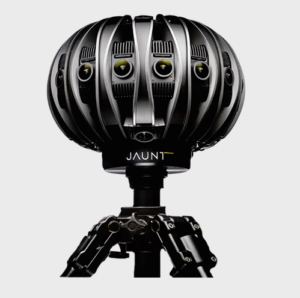Jaunt: Netflix Meets Gopro Meets Hollywood Studio..for VR

Can a hardware, software, and content creator bring VR media to the masses?
Jaunt is a VR media company that builds hardware, software, and apps to create high-quality VR content. The Palo Alto-based company has already raised over $100M from investors such as The Walt Disney Company and Highland Capital Partners.
The company is planning to create a database of VR content that can be distributed to consumers through apps and consumed via VR headsets. Jaunt’s app is also available on all major VR platforms directly. A PlayStation VR owner, for example, can have access to Jaunt’s library of over 200 pieces of content. It has partnered with filmmakers to develop programming – everything from concerts to sports games to entire series. In the words of Tom Vance, the head of content, “The idea is to drive commercialization and bring VR to the mass market by partnering with really polished filmmakers.”[1]
Value Creation
Jaunt enables both creators and users to develop and consume content in new, exciting ways. For consumers, Jaunt is available on a wide variety of platforms, making the content accessible for anyone with access to a VR headset. The experience of watching Jaunt’s films is immersive, fun, and exciting. Jaunt’s high-quality content is a product of its investment in state-of-the-art hardware (cameras) and software (editing) tools.
For device manufacturers, the Jaunt content library is a highly valuable asset in attracting more buyers. For example, gamers comprise PlayStation VR’s core customer base. But if PlayStation can provide a broad array of exciting content uniquely positioned for consumption on its platform, it may be able to attract a much broader customer set.[2]
For filmmakers and production companies, Jaunt offers not just a platform for content distribution, but also a suite of tools necessary for creating the next-generation version of media content. In a move compared to the Gopro, the company no2 sells the Jaunt ONE, its professional-grade VR camera.[3] Technically, the camera is available to consumers (not just Jaunt’s professional partners) – but at the price tag of $95,000, it seems unlikely that to be used by anyone other than professionals.

Value Capture
Jaunt does not share its value capture model publicly, but for now, its content is free for consumers and it does not advertise on its videos. The company plans to make revenue through sales of its hardware and software, but I predict these will be slow to take off. I imagine it will charge for use of its new production studio, Jaunt Studios. In the future, the company may consider charging small fees for access to content (a la the Netflix model) and including brief ads (which should command a hefty premium for this engaging new technology). It should explore licensing/revenue share agreements for specific, exclusive feature films as well.
Looking Ahead and Around…360 Degrees
However, challenges remain. The potential audience for this content is still small, in part restricted by the high price tags of VR headsets. In a chicken-and-egg problem, the lack of content available for consumption has contributed to slow adoption rates. Jaunt is hoping that its content can be a draw for new users and betting that it can benefit from first (or early)-mover advantage.[4]
Furthermore, Jaunt is trying to develop a number of core competencies at once: software, hardware, and content creation. This entails manufacturing, distribution, app development, partnerships, filmmaking abilities, and more. They are targeting large Hollywood studio partners, as well as high-quality independent content creators. With the urge to grow quickly and to be accessible for both consumers and content creators, the company risks biting off more than it can chew.
I recommend that Jaunt keep its content creation efforts highly focused as it begins to grow. This means partnering only with bigger-name production studios and directors to create extremely high-quality content that generates significant buzz and anticipation through marketing and PR. Jaunt is well-positioned to leverage its headset makers as marketing partners – incentives are aligned to attract new users to a nascent industry. Indirect network effects are important as the industry gains traction; great content from Jaunt may encourage more users to purchase headsets, which in turn will spur more content creation. Once headset manufacturers can achieve greater scale efficiencies, they can drop prices to continue the cycle.
Jaunt will need to continue to experiment as it determines its business model. Owning the end-to-end VR content creation and distribution is a lofty goal, but I believe Jaunt is well-positioned to take on the task.
[1] http://www.cnbc.com/2017/02/08/disneys-big-start-up-bet-that-could-revolutionize-film.html
[2] https://venturebeat.com/2016/12/22/jaunt-lets-you-watch-vr-movies-on-the-playstation-vr/
[3] https://thevideoink.com/is-jaunt-one-the-modern-day-gopro-vr-startup-answers-consumers-demands-for-vr-cameras-32ab261b7a05
[4] https://www.inc.com/jeremy-quittner/best-industries-2016-virtual-reality.html
[5] https://www.jauntvr.com/


